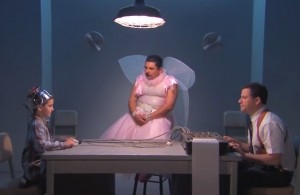What Happens When You Attach Kids to a Fake Lie Detector

When the examinee believes the device to be omniscient, or able to see into their very thoughts, it influences the examinee to reveal the truth.
By Brian Del Rosario, Marketing —
Kids say the darndest things, especially when those things are not all true. Discerning whether a child is telling the truth or not can be very difficult. Comedian Jimmy Kimmel has a solution to figure out which are exaggerations and which are truth (video). Jimmy attached kids to a fake lie detector. He explained to each child that the lie detector machine knows whether they are telling the truth or not, and it will buzz if a lie is told. When the children say something unbelievable, Jimmy has his “lie detector” buzz. Confused by the buzz and caught off guard, the children begin to tell the truth. While he might be lying to get the truth, the method proved quite effective.
The Effectiveness of Fake Security
This occurrence is explained in John B. Miner’s and Michael H. Capps’s book, How Honesty Testing Works. The authors suggest that the mere state of being attached to a polygraph may influence the outcome of the examination. They explain that many candidates assume the device to be omniscient. When the examinee believes the device to be omniscient, or able to see into their very thoughts, it influences the examinee to reveal the truth. While many applicants might not confess to everything, uncertainty will show and some amount of a confession will be made. Their observation echoes what we observe in the funny episode of Jimmy Kimmel. While those might have been kids, the same goes for adults.
The same principle is found in the use of fake security. For years, homeowners and retail stores have utilized fake security cameras to deter theft and criminal activity. Some might question whether the presence of fake security does any good at all, being fake or not. In 2008, a group at UC Berkeley conducted a six-month study observing crime patterns around surveillance cameras in the San Francisco area (study). The study found that homicides declined where surveillance cameras were placed; those crimes being pushed away to other parts of the city. The study also found that property crime decreased in surveillance camera areas. The research revealed that the presence of surveillance influences trustworthy behavior in individuals.
An additional study conducted by Doctors of Philosophy from Eastern Kentucky University, the University of North Carolina at Charlotte, and Western Illinois University, sought to determine what situational factors deter burglars from their criminal behavior (study). Through surveys and interviews, researchers found that about four in five incarcerated respondents say they would observe to see if an alarm system was armed in the premise before attempting a burglary. The results showed that more than half the intruders would abort their burglary upon noting the presence of an alarm system. The study also stated that a majority of the burglars considered the presence of alarms, surveillance cameras, and security officers before attempting the burglary.
The Mere Use of Lie Detection Helps Deter Dishonesty
The studies mentioned above help us understand that the presence of some form of surveillance helps deter criminals and provides convincing situations for criminals to avoid or cease their dishonest activity. Whether the security feature is real or not, when the criminal perceives it to be effective, they abort.
Lie detection is an advanced form of surveillance that governments, employers, and citizens use to deter dishonesty and uncover the truth. There are many forms of lie detection, including polygraph examinations, voice stress analyses, brain fingerprinting, eye-tracking, and the utilization of truth drugs. Each of these forms provide many reasons to be utilized, but one of the most effective features of these forms is the mental influence that they have on the examinees. Just as the presence of surveillance cameras have strong effect on burglars, lie detection utilization in hiring and admission processes can have strong influence on filtering out people of bad moral character. When applicants to a job or immigrants hoping to enter a sovereign state understand that lie detection is being utilized in the admission process, they might just think twice about lying about their previous misconducts or background.
Implementing Mass Polygraph Examinations as an Effective Security Feature?
You can’t implement mass polygraph examinations. They usually take 2 to 3 hours to complete. These examinations also require an examiner that must be mentally focused in order to interpret measurements from the device’s readings of the examinee.
Other lie detection technologies can conduct examinations at quicker speeds but may require longer times to process and interpret data. These methods might include invasive techniques that require an examiner to attach multiple devices to an examinees body.
Eye-tracking is one of the possible technology solutions for a large-scale lie detection security to be implemented. Educational psychologists from the University of Utah have been researching the use of eye-tracking and its use in lie detection. Eye-tracking lie detection requires one-fifth of the time typically required for polygraph examinations and does not require a polygraph examiner to administer the examinations. This lie-detection is also more economical than other technologies.
The utilization of eye-tracking technology for lie detection can by the very implementation deter dishonesty, and begin to uncover truth for those daring to try its accuracy.
Source
Photo courtesy of The Jimmy Kimmel Show.

